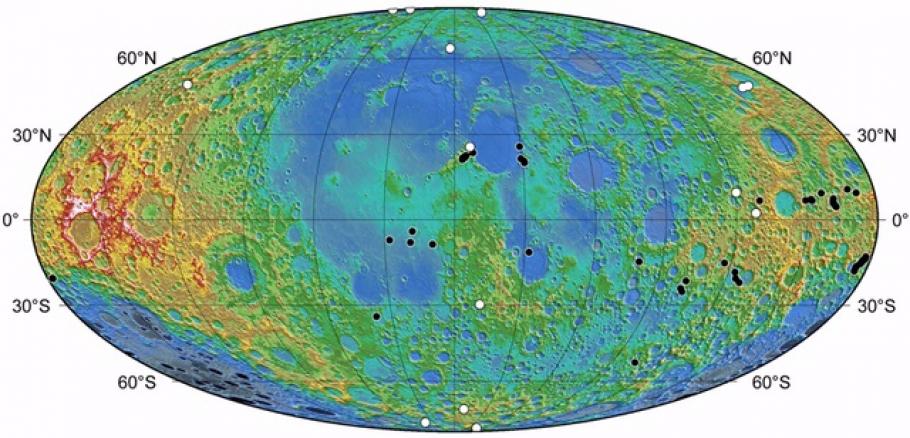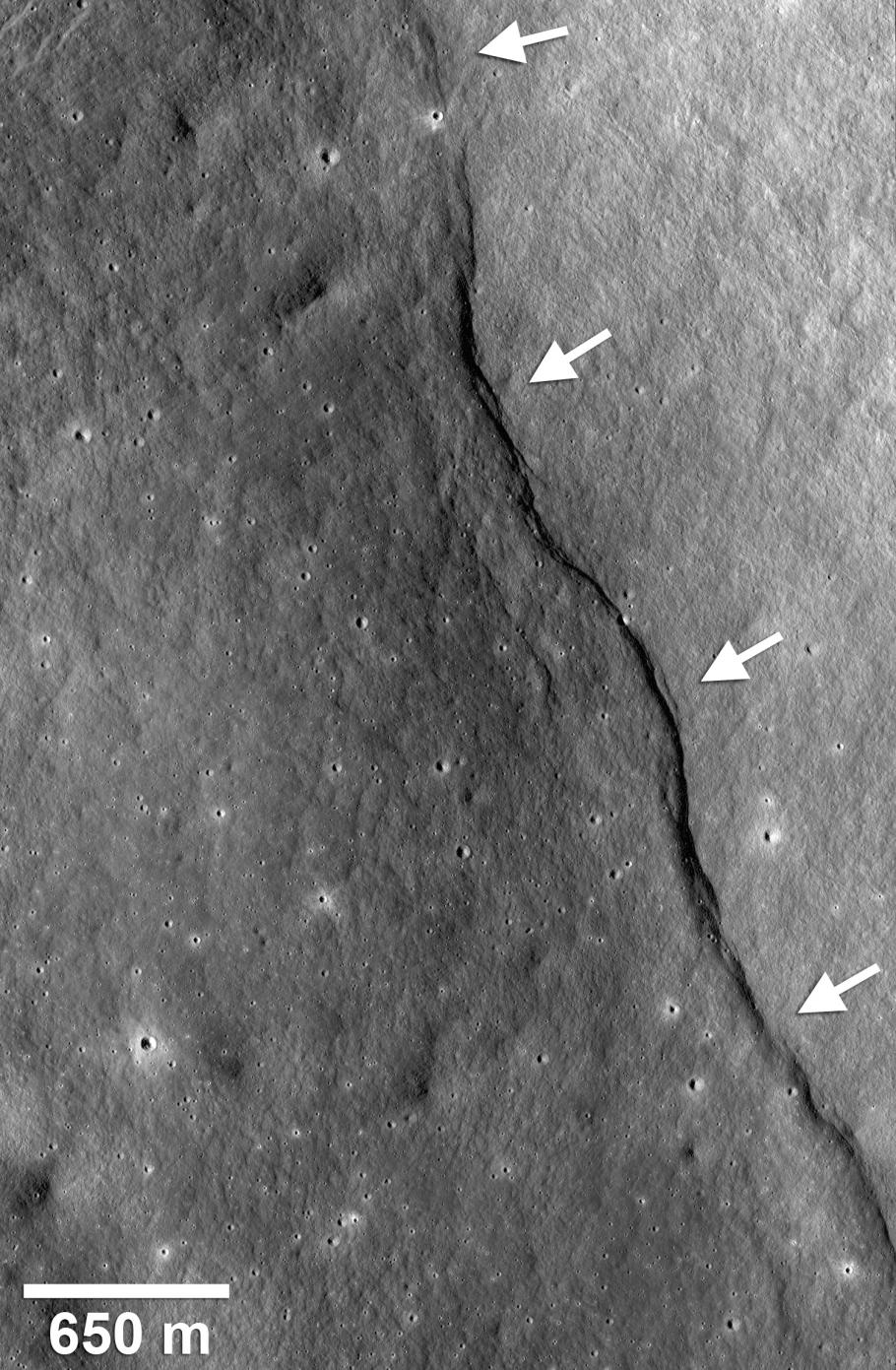What is different about the lobate scarps on the moon compared to other planets?
Young Mistake Scarps on the Moon
The most well known tectonic landforms on the Moon are institute in and around the nearside mare basins. Contraction ridges, formed by contraction, and rilles or troughs, formed by extension, deform the mare basalt-filled touch basins and the adjacent highlands. The wrinkle ridges and extensional troughs are the upshot of loading from mare basalts that causes downward flexure of the lunar lithosphere, resulting in wrinkle in the interior of the basin and extension most the margins.
Tectonic landforms on the Moon not straight associated with the mare basins are lobate scarps. Lobate scarps look like stair-steps in the mural; they are i-sided and often accept lobate fronts. These landforms are the surface express of thrust faults. Thrust faults are a break in the nigh-surface materials formed when crustal materials are contracted or pushed together. Crustal material is thrust upwardly forth the mistake forming a scarp.
Lobate scarps were first establish in the highest resolution images and photographs taken by the Lunar Orbiters and the Panoramic Cameras flow on the Apollo fifteen, 16, and 17 missions. Because these loftier resolution images and photographs covered only a small area of the surface confined by and large to the lunar equatorial zone, it was non known how widely distributed lobate scarps were on the Moon.
The Lunar Reconnaissance Orbiter, launch in June, 2009, is returning the highest resolution images of the Moon ever obtained from orbit. These images, taken by the Lunar Reconnaissance Orbiter Photographic camera (LROC) Narrow Bending Cameras (NACs), accept a resolution of 0.5 to 2 meter per pixel. The new NAC images are being used to search for previously unknown lobate scarps.
Newly discovered lobate scarps are existence plant in the LROC images. Many of the previously undetected mistake scarps are located at high lunar latitudes and some accept been found near the lunar poles.1 Lunar scarps plant well exterior the equatorial zone indicate that they are globally distributed.

A plot of the locations of newly detected and previously known lobate scarps shows that the faults are globally distributed. The newly discovered lobate scarps are shown by the white dots and the previously known scarps are shown past black dots. Most of the previously known lobate scarps were found in Apollo Panoramic Camera photographs that covered just office of the lunar equatorial region. The locations of the lobate scarps are plotted on the Lunar Orbiter Laser Altimeter (LOLA) global topographic model of the Moon. Credit: NASA/GSFC/Arizona Land University/Smithsonian

The lobate scarps were formed when the lunar crust was pushed together equally the Moon contracted. This causes the most-surface materials to break forming a thrust fault. The thrust fault carries crustal materials up and sometimes over adjacent crustal materials.

Over recent geologic fourth dimension, every bit the lunar interior cooled and contracted the entire Moon shrank by nigh 100 g. As a result its brittle chaff ruptured and thrust faults (compression) formed distinctive landforms known as lobate scarps. In a particularly dramatic example, a thrust fault pushed crustal materials (arrows) upwardly the side of the farside impact crater named Gregory (two.1°N, 128.1°E). Past mapping the distribution and determining the size of all lobate scarps, the tectonic and thermal history of the Moon can be reconstructed over the past billion years.
Over recent geologic time, as the lunar interior cooled and contracted the entire Moon shrank past about 100 meters (328 feet). As a outcome its brittle crust ruptured and thrust faults (compression) formed distinctive landforms known every bit lobate scarps. In a specially dramatic example, a thrust error pushed crustal materials (arrows) up the side of the farside bear upon crater named Gregory (2.1°Northward, 128.1°E). By mapping the distribution and determining the size of all lobate scarps, the tectonic and thermal history of the Moon can be reconstructed over the by billion years. Credit: NASA/GSFC/Arizona State Academy/Smithsonian
The most likely reason for the germination of the lobate scarps is global wrinkle caused by interior cooling. The loss of heat from the Moon's interior results in contraction. Although the lobate scarps indicate contraction, the Moon has not contracted by much in the recent past. The total radial contraction or subtract in the Moon's radius is estimated to exist but about 100 meters.
The historic period of lobate scarps is also being investigated. Examining the crosscutting relations between the fault scarps and small bore touch on craters, their historic period is estimated to be no more than ane billion year former. An even younger historic period for the scarps is suggested past the lack of superimposed, large-diameter impact craters. Also, the scarps are very pristine and undegraded. The young historic period of the fault scarps indicates that the Moon has contracted very recently.
1. Watters, Thomas R., Robinson, Marker Due south., Beyer, Ross A., Banks, Maria E., Bell, James F. Iii, Pritchard, Matthew Eastward., Hiesinger, Harald, van der Bogert, Carolyn H., Thomas, Peter C., Turtle, Elizabeth P., Williams, Nathan R. 2010. "Bear witness of Recent Thrust Faulting on the Moon Revealed past the Lunar Reconnaissance Orbiter Camera." Science 329.5994. 936 - 940.
Source: https://airandspace.si.edu/research/projects/young-fault-scarps-moon
0 Response to "What is different about the lobate scarps on the moon compared to other planets?"
Post a Comment